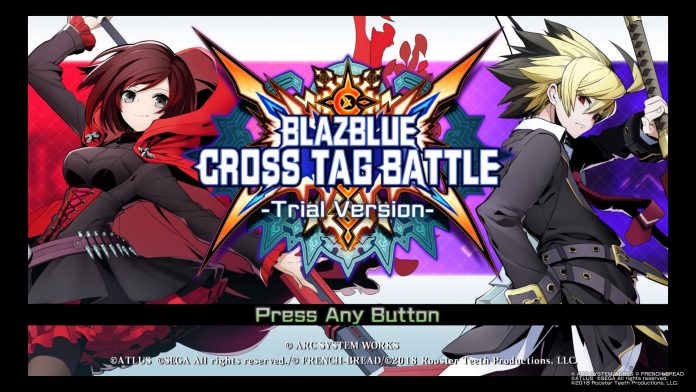Cross-overs are a fairly interesting beast, given that they need to cater to many different fandom as well as newcomers; they are arguably at their most rewarding when one is a fan of all the properties involved – since it captures the same childhood feelings of smashing two action figures together or telling your friends that “Goku could totally beat up Superman.”
As a long-time fan of fighting games, then, it’s only natural that Blazblue: Cross Tag Battle would warm my ice-cold heart; not only is it something new to pick up and learn, but it also contains four of my favourite franchises – not just in the genre, but overall! ArcSystem Works tends to treat its franchises with care, but that still begs the question: is Cross Tag a fun fledgling fighter worth fighting for, or is it a developer’s dastardly double-cross instead?
* Note: This is based on the Open Beta / demo version.

Visuals and Sound Design
Cross Tag’s main strength overall is also, regrettably, its biggest weakness; a glance at the HUD alone shows that this deceptively simple game has far too much unnecessary bloat and some curious design decisions. For example, there are no less than four different bars [HP, Skill, Cross, Resonance] to keep track of – which, while not a problem on its own, leaves a player wondering why a standard super gauge wouldn’t suffice or why they couldn’t have been organized better.

Looking at the image above, for example, Dragon Ball FighterZ (another ArcSys game with a similar concept) only has HP, Assist, Super, and “Sparking” gauges. While Cross Tag’s is similarly laid out and with similar functions, the DBZ template is much easier on the eyes.
However, the various gauges don’t necessarily clutter the screen insomuch as they distract a player. Getting past that makes it apparent that the character sprites and backgrounds are recycled from Cross Tag’s source material; the game certainly looks beautiful when in motion given that ArcSys tends to handcraft each individual frame, but looking at Ruby’s sprite (a new one for this game) next to Ragna’s (1-11 year old one) highlights just how aged the older sprites truly are.

Of course, the graphical issues could be chalked up to different art styles – but the Under Night In-Birth characters have been redrawn and still seem leagues better than their aged counterparts!
On the aural side of things, the soundtrack is also pulled from the game’s source material and – while a matter of personal preference – it contains a fairly decent selection of tracks similarly to a “best of” album. The SFX, new and old, are rather punchy; they often lend attacks speed, weight, or both whenever applicable. It was also interesting to hear the Under Night In-Birth characters get their first official EN voices, though I have no real feelings on them one way or another.
Gameplay

Gameplay-wise, Cross Tag battle is a mixed bag. The game itself has been grossly simplified to the point of neutering old characters – and even basic things like inputs have changed for most of the cast. This issue stands in stark contrast to the overabundance of system that, while giving players a lot of different options, are difficult to learn and harder to remember.
At the very least, though, the gameplay is as-expected from ArcSys: fast and satisfying, allowing a skilled player to rack up massive combos if they know the right timings and buttons. The tag system is arguably the game’s best offering; even compared to other “team” fighters, Cross Tag really does make a player feel like they’re controlling a team of characters.
Although the simplified control scheme is difficult for long-time fans due to muscle memory, the game’s true problem is its roster. On launch, the game is scheduled for 20 characters – all of whom were present from the beta and with another 20 to be added as DLC. It’s unfortunately and abundantly clear that Blazblue is ArcSys’ favourite child, since they take up the majority of the base roster – a fact that serves to highlight quite a few notable holes. Where are characters like Blake, Yang, and literally anyone from Persona 3?
If you answered “relegated to DLC,” you would be correct. While the rest of Team RWBY will be free at launch, the other offerings are paid and postponed. Even though the game’s director has noted it’s for “less than the retail price,” it still seems problematic given the recycled assets and neutered move-sets.
Online Play
Regrettably, I was not able to try actual online play during the beta; however, Cross Tag uses a lobby system similar to Dragon Ball FighterZ’s: characters walk around an open-ended environment and interact with various little kiosks – though a menu is also accessible for those who want to cut the exploration and get right into gameplay. This balanced system works well, though I’d be curious as to how the connection is given recent issues with Under Night In-Birth, Blazblue: Central Fiction, and early DBZ.
Conclusion

I have extremely mixed feelings about Cross Tag Battle; on the one hand, it’s undeniably fun and love was clearly put into it – doubly so since characters have unique intros with their partners. Unfortunately, though, the game sets a rather dangerous precedent for its genre as a whole. Even putting aside my personal feelings about the genre and what it should be, the game lacks identity: it clearly wants to be accessible for everyone, but in practice it’s actually not.
In conclusion, then, I’d like to return to my original analogy: the game is like banging action figures together; there’s no consistency as far as rules or tone, even if it’s fun for a period of time. Personally, I think it’s an interesting gateway into its different series, but it also breeds a degree of complacency that might make players feel daunted.



